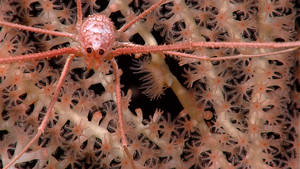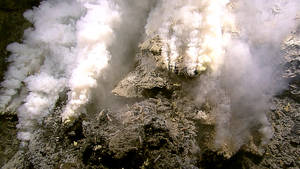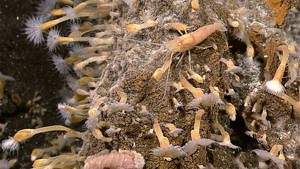Social networking tools help deep sea explorers
Interview with
Pioneering exploration of Indonesia's deep sea uses latest social networking tools to link up a virtual global laboratory.
Tim - In this case we were doing something really novel. We had a remotely operated vehicle, so we had a robot that had a very good high definition camera system. We were doing pure exploration of the seafloor.
No one had ever been to this area of Indonesia, north of Indonesia in the Sulawesi Sea. The vehicle wasn't novel in itself but the signal that was coming off the seafloor was transported around the world. There were scientists in Indonesia and various parts of the US, in Europe, in the UK, that were all tuning in at the same time. We have Skype and iChat going.
 And as we saw live pictures coming in we could hear the pilots of the ROV onboard the ship, we could hear everybody on the ship we wanted to and we could communicate with everyone who was listening in. We had also conference calls going on at the same time. So we had voice, we had iChat, we had Skype. So that to me was a real first. And so we were able to see things in real time and say what we thought we were seeing.
And as we saw live pictures coming in we could hear the pilots of the ROV onboard the ship, we could hear everybody on the ship we wanted to and we could communicate with everyone who was listening in. We had also conference calls going on at the same time. So we had voice, we had iChat, we had Skype. So that to me was a real first. And so we were able to see things in real time and say what we thought we were seeing.
So what we did was we documented what's on the deep seafloor north of Indonesia and we had some remarkable results.
In short, we found very high diversity. We found diversity that rivals that of the shallow water coral triangle area. The region we looked at was between 300m and 5000 m deep. So we covered a lot of different kinds of habitats - mid ocean rift habitats, a lot of deep sediment habitats.
We actually found wood and coconuts that were being uses as habitats by certain species. There's lots of wood that falls into the water in this part of the world and it actually hosts a different kind of chemosynthetic community, those communities that live on decaying material.
We think we found more that 40 new coral species and even more other invertebrate species. So it's a really dramatic find.
Helen - You mention the fact that there's a lot of wood down there, which is fascinating. But there are other chemosynthetic organisms down there that are living off these interesting chemicals down there on these sea mounts. What's going on with those?
Tim - The sea mount where we found these hydrothermal vents is called Kawio  Barat and we found clams in the outlying sediment that have bacteria in their gills that allow them to take in nutrients and give it to the clam as the host. So it's a symbiotic relationship that allows them to live there.
Barat and we found clams in the outlying sediment that have bacteria in their gills that allow them to take in nutrients and give it to the clam as the host. So it's a symbiotic relationship that allows them to live there.
So we saw lots of clams as we proceeded away from the actual vents themselves. At the vents where the waters coming out we saw a lot of shrimp and a lot of barnacles. These are stalked barnacles that may be 8-10 inches long. They're so numerous. Sometimes we liken it to going through a car wash. They're on ever side of these large chimneys, we call them, like large spires. And they love being there, they're very tough. They love being up into the current where they get nutrients that come in and they're only around these vent systems.
And so we're still trying to identify which species it is - it may be a new species to us. As well as the shrimp that live there. They live in very large numbers and they walk right along the top of the chimneys and through the water coming out.
And there may be three species of those, we're not sure yet.
Helen - Very exciting. So I guess there's an awful lot we still need to discover about these habitats? There must be most questions than answers at the moment?
 Tim - Oh yeah. Every time we had a dive, whether it was shallow water or deep, we found something new.
Tim - Oh yeah. Every time we had a dive, whether it was shallow water or deep, we found something new.
The amount of diversity we saw at 300m was really remarkable. And the coloration of the animals - they blended into their surroundings. Even at 300m where it's black, pitch black to us, they seem to be using camouflague for some reason. They still have it, for some reason they haven't lost their ability to have camouflage.
When you go deeper you loose that colour. We were seeing wood at 3000-4000m, all the animals were white. They were nothing like anything we'd seen anywhere else in the sediment or the vents of anywhere else.
The thing is with this vehicle we had, we couldn't sample. So we couldn't bring them back to the lab and dissect and play with their morphology. We could just take pictures and video.
That said the high definition video was very of high resolution, so we were able to get in really close. In some cases count the little hairs on the back of the shrimp that helps us identify who they are. And that's what we're in the process of doing now, is identifying who all these species are. Again, remarkable diversity so it will take some time.
Helen - You mention that this is the beginning, you expedition to Indonesia this year was the beginning of a long term project. What's next for that project?
Tim - This was year one of five actually. We have planned another cruise to the east of where we were last year, it's called Halmahera. We think is has chemosynthetic communities there. It's not venting there, it's seeping, it's coming up through sediments. So it's cold nutrients that are coming up.
We normally in those areas see clams and shrimp and tube worms. We're looking forward to it. It'll be a another month-month and a half long cruise to there. And I know we're going to find some really incredible stuff.
Find out more
Tim Shank's Lab at Woods Hole Oceanographic Institution
NOAA ship Okeanos Explorer










Comments
Add a comment